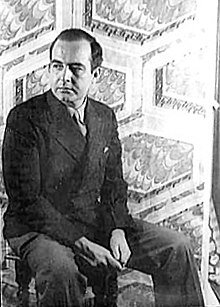 Global Information
Global InformationSamuel Barber information
Samuel Barber | |
|---|---|
 | |
| Born | March 9, 1910 |
| Died | January 23, 1981 (aged 70) |
| Occupations |
|
| Works | List of compositions |
| Partner | Gian Carlo Menotti |
| Awards | Pulitzer Prize |
| Signature | |
Samuel Osmond Barber II (March 9, 1910 – January 23, 1981) was an American composer, pianist, conductor, baritone, and music educator, and one of the most celebrated composers of the mid-20th century.[1] Principally influenced by nine years' composition studies with Rosario Scalero at the Curtis Institute and more than 25 years' study with his uncle, the composer Sidney Homer, Barber's music usually eschewed the experimental trends of musical modernism in favor of traditional 19th-century harmonic language and formal structure embracing lyricism and emotional expression. However, he adopted elements of modernism after 1940 in some of his compositions, such as an increased use of dissonance and chromaticism in the Cello Concerto (1945) and Medea's Dance of Vengeance (1955); and the use of tonal ambiguity and a narrow use of serialism in his Piano Sonata (1949), Prayers of Kierkegaard (1954), and Nocturne (1959).
Barber was adept at both instrumental and vocal music. His works became successful on the international stage and many of his compositions enjoyed rapid adoption into the classical performance canon. In particular, his Adagio for Strings (1936) has earned a permanent place in the orchestral concert repertory, as has that work's adaptation for chorus, Agnus Dei (1967). He received the Pulitzer Prize for Music twice: for his opera Vanessa (1956–57), and for the Concerto for Piano and Orchestra (1962). Also widely performed is his Knoxville: Summer of 1915 (1947), a setting for soprano and orchestra of a prose text by James Agee. At the time of Barber's death, nearly all of his compositions had been recorded.[2] Many of his compositions were commissioned or first performed by such noted groups and artists as the Boston Symphony Orchestra, the Philadelphia Orchestra, the New York Philharmonic, the Metropolitan Opera, Vladimir Horowitz, Eleanor Steber, Raya Garbousova, John Browning, Leontyne Price, Pierre Bernac, Francis Poulenc, and Dietrich Fischer-Dieskau.[2]
While Barber composed a significant body of purely instrumental music, two-thirds of his compositional output was art songs for voice and piano, choral music, and songs for voice and orchestra. Some of his most frequently performed songs include both the solo voice and choral versions of Sure on this shining night (solo version from 1938 and choral version from 1961) with text by Agee; and the song cycle Hermit Songs (1953), with anonymous texts by Irish monks from the eighth through thirteenth centuries. This emphasis on sung material was rooted in his own brief career as a professional baritone in his 20s which inspired a lifelong love of vocal music. In 1935, Barber recorded his own setting of Arnold's "Dover Beach" for NBC, singing the vocal part accompanied by string quartet,[3] and he was also featured weekly on NBC Radio in 1935–1936 performing German lieder and art songs. He also occasionally conducted performances and recordings of his works with symphony orchestras during the 1950s, and taught composition at the Curtis Institute from 1939 to 1942.
Barber was in a relationship with the composer Gian Carlo Menotti for more than 40 years. They lived at Capricorn, a house just north of New York City, where they frequently hosted parties with academic and music luminaries. Menotti was Barber's librettist for two of his three operas. When the relationship ended in 1970, they remained close friends until Barber's death from cancer in 1981.
- ^ Heyman 2001: "One of the most honoured and most frequently performed American composers in Europe and the Americas during the mid-20th century, Barber pursued, throughout his career, a path marked by a vocally inspired lyricism and a commitment to the tonal language and many of the forms of late 19th-century music. Almost all of his published works – including at least one composition in nearly every genre – entered the repertory soon after he wrote them and many continue to be widely performed today."
- ^ a b Donal Henahan (January 24, 1981). "Samuel Barber, Composer, Dead: Twice Winner of Pulitzer Prize". The New York Times.
- ^ Available in a multi-disk CD set "Samuel Barber Historical Recordings 1935-1960", Disk 8 Track 1.